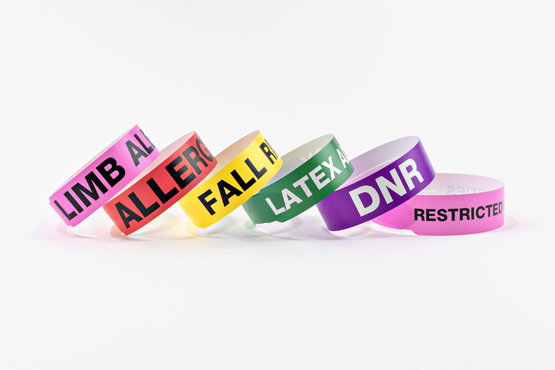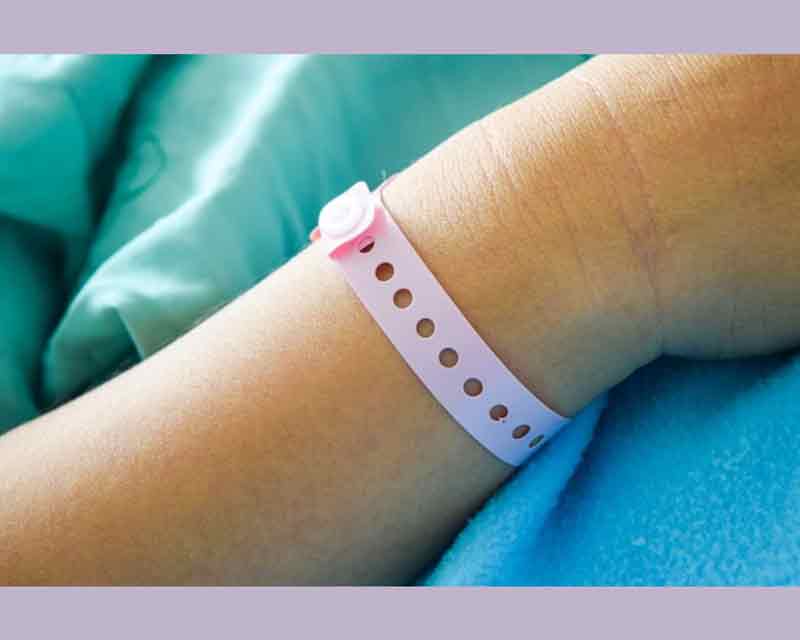Choosing the Right Substances for Your Patient Identification Band: A Step-by-Step Guide
Choosing the Right Substances for Your Patient Identification Band: A Step-by-Step Guide
Blog Article
Checking Out the Various Kinds Of Patient Identification Band Utilized in Medical Facilities
In the intricate globe of health care, the vital function of Patient Identification bands often goes undetected. These bands, varying from easy paper wristbands to innovative RFID bands, develop the backbone of Patient safety methods, making sure precision in Patient Identification. The substantial diversity of these bands, each with its distinct advantages and restrictions, is often ignored. As we navigate with this subject, one may obtain insight right into the subtle intricacies and crucial value of such bands in medical centers.
Recognizing the Significance of Patient Identification Bands
While they may appear like plain accessories, Patient Identification bands play an important function in clinical facilities. These bands function as a vital tool for validating Patient identification, avoiding clinical errors connected to misidentification. The bands commonly show vital info such as the Patient's name, age, blood group, and any kind of known allergies. They enable medical care professionals to promptly access this essential details, therefore assisting in accurate and punctual medical treatment. Patient Identification bands likewise help in streamlining administrative jobs, making sure exact record-keeping and billing. Regardless of their simpleness, these bands symbolize the concept of Patient security, a keystone of top quality healthcare. Without them, the threat of clinical errors, and as a result, Patient harm, could considerably enhance.
Traditional Paper Wristbands: Their Use and Limitations
Standard paper wristbands have actually been a staple in Patient Identification throughout numerous medical centers. While their use is extensive, they harbor particular constraints that might impact their effectiveness in Patient administration. This area will certainly concentrate on the scope of their application and the fundamental downsides related to their use.
Paper Wristbands: Usage Scope
In the world of Patient Identification, paper wristbands have long held a vital duty. These bands are commonly utilized in outpatient settings, where the Patient's stay is temporary. The wristbands contain vital information such as the Patient's name, day of birth, and a distinct Identification number. This straightforward, yet efficient system, permits physician to promptly and properly recognize people, making sure the right therapy is carried out. Paper wristbands are also utilized in emergency scenarios, where fast Identification is extremely important. Their usage prolongs to occasions like blood donation drives and mass inoculation programs, additionally highlighting their flexibility. Despite developments in technology, the humble paper wristband continues to be a cost-efficient and trustworthy remedy for Patient Identification in different health care scenarios.
Limitations of Paper Wristbands
In spite of their extensive usage, paper wristbands are not without their downsides. In addition, paper wristbands typically lack the technological capabilities of more contemporary alternatives, such as barcoding or RFID chips, limiting their performance to just displaying created dig this information. Paper wristbands can cause pain or skin irritability to some individuals, particularly when worn for prolonged durations.
Barcoded Wristbands: Innovations in Patient Identification
While Patient Identification has actually long been an essential aspect of medical care, the arrival of barcoded view website wristbands represents a substantial jump ahead. These bands utilize the simpleness of barcoding technology, enabling for Patient info to be rapidly scanned and accessed. They improve the speed and precision of Patient Identification, minimizing the risk of medical errors associated to misidentification.
Superhigh Frequency Identification (RFID) Bands: a Step In The Direction Of Futuristic Health Care
The evolution of Patient Identification bands has caused the introduction of Superhigh frequency Identification (RFID) Bands (patient identification band). These ingenious tools existing essential benefits for healthcare centers, offering a much more efficient and technically progressed methods of Patient Identification. The application of RFID in health care is a significant step in the direction of an extra advanced strategy to Patient management and safety and security
Comprehending RFID Bands

RFID Bands: Key Benefits
Mainly, these bands improve Patient safety by providing accurate, immediate Identification, consequently minimizing medical errors. RFID bands can save a vast quantity of Patient information, including clinical background and allergic reactions, enabling individualized care. Generally, RFID bands represent a considerable advancement in find here Patient Identification technology, benefiting both clients and medical care companies.
Implementing RFID in Healthcare
As we tip into a technologically innovative age, the implementation of RFID bands in healthcare becomes increasingly crucial. These bands supply a seamless means to track and identify individuals, ensuring their safety and security and improving effectiveness in therapy procedures. RFID bands supply countless benefits over conventional Identification approaches. They can save a substantial quantity of data, including the Patient's case history and treatment plans, which can be conveniently accessed by doctor. This information helps physicians make educated choices regarding the Patient's treatment strategy. RFID bands decrease clinical errors by supplying accurate Patient Identification, which is critical in preventing misdiagnosis or wrong medication administration. Therefore, the execution of RFID bands is a substantial action in the direction of boosting Patient safety and medical care shipment.

Color-Coded Wristbands: Helping in Quick and Accurate Medical Diagnosis
In the dynamic environment of a clinical center, color-coded wristbands have arised as essential tools for swift and exact Identification of a patient's clinical problem. These wristbands, used by clients, bring details colors that correspond to various medical conditions or conditions. This system is developed to supply instant aesthetic hints to healthcare service providers, improving Patient security and care top quality.
Strategies for Efficient Application and Monitoring of Patient ID Bands
Attaining ideal use of Patient Identification bands demands a well-structured method for their application and management. Patient education is also crucial; individuals should understand the objective of the bands and the requirement for their continuous wear. It's important to have a back-up plan in place, such as barcode scanning or biometrics, to guarantee that Patient Identification is never jeopardized.
Final thought
Patient Identification bands are critical in clinical facilities to make sure safety and precision. Efficient execution and monitoring of these bands can significantly minimize clinical mistakes, enhance performance, and boost overall Patient care.
These bands, varying from simple paper wristbands to advanced RFID bands, form the foundation of Patient safety and security methods, making certain precision in Patient Identification.The evolution of Patient Identification bands has actually brought about the introduction of Radio Regularity Identification (RFID) Bands. Overall, RFID bands represent a substantial innovation in Patient Identification innovation, benefiting both individuals and health care service providers.
RFID bands decrease medical errors by giving exact Patient Identification, which is important in stopping misdiagnosis or wrong medication administration. Patient education and learning is additionally critical; people have to recognize the function of the bands and the requirement for their consistent wear.
Report this page